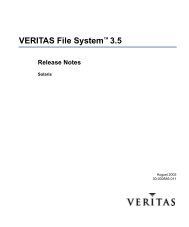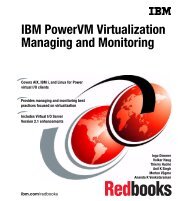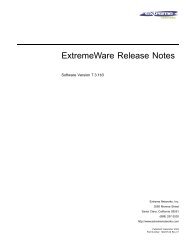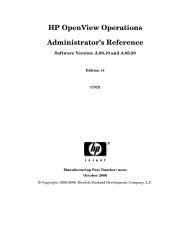HP-UX VxFS tuning and performance - filibeto.org
HP-UX VxFS tuning and performance - filibeto.org
HP-UX VxFS tuning and performance - filibeto.org
Create successful ePaper yourself
Turn your PDF publications into a flip-book with our unique Google optimized e-Paper software.
22<br />
cio<br />
The cio option enables the file system for concurrent I/O.<br />
Prior to <strong>VxFS</strong> 5.0.1, a separate license was needed to use the concurrent I/O feature. Beginning with<br />
<strong>VxFS</strong> 5.0.1, concurrent I/O is available with the OnlineJFS license. Concurrent I/O is recommended<br />
with applications which support its use.<br />
remount<br />
The remount option allows for a file system to be remounted online with different mount options. The<br />
mount -o remount can be done online without taking down the application accessing the file system.<br />
During the remount, all file I/O is flushed to disk <strong>and</strong> subsequent I/O operations are frozen until the<br />
remount is complete. The remount option can result in a stall for some operations. Applications that<br />
are sensitive to timeouts, such as Oracle Clusterware, should avoid having the file systems remounted<br />
online.<br />
Intent log options<br />
There are 3 levels of transaction logging:<br />
tmplog – Most transaction flushes to the Intent Log are delayed, so some recent changes to the file<br />
system will be lost in the event of a system crash.<br />
delaylog – Some transaction flushes are delayed.<br />
log – Most all structural changes are logged before the system call returns to the application.<br />
Tmplog, delaylog, log options all guarantee the structural integrity of the file system in the event of a<br />
system crash by replaying the Intent Log during fsck. However, depending on the level of logging,<br />
some recent file system changes may be lost in the event of a system crash.<br />
There are some common misunderst<strong>and</strong>ings regarding the log levels. For read() <strong>and</strong> write() system<br />
calls, the log levels have no effect. For asynchronous write() system calls, the log flush is always<br />
delayed until after the system call is complete. The log flush will be performed when the actual user<br />
data is written to disk. For synchronous write() systems calls, the log flush is always performed prior to<br />
the completion of the write() system call. Outside of changing the file‟s access timestamp in the inode,<br />
a read() system call makes no structural changes, thus does not log any information.<br />
The following table identifies which operations cause the Intent Log to be written to disk synchronously<br />
(flushed), or if the flushing of the Intent Log is delayed until sometime after the system call is complete<br />
(delayed).
















